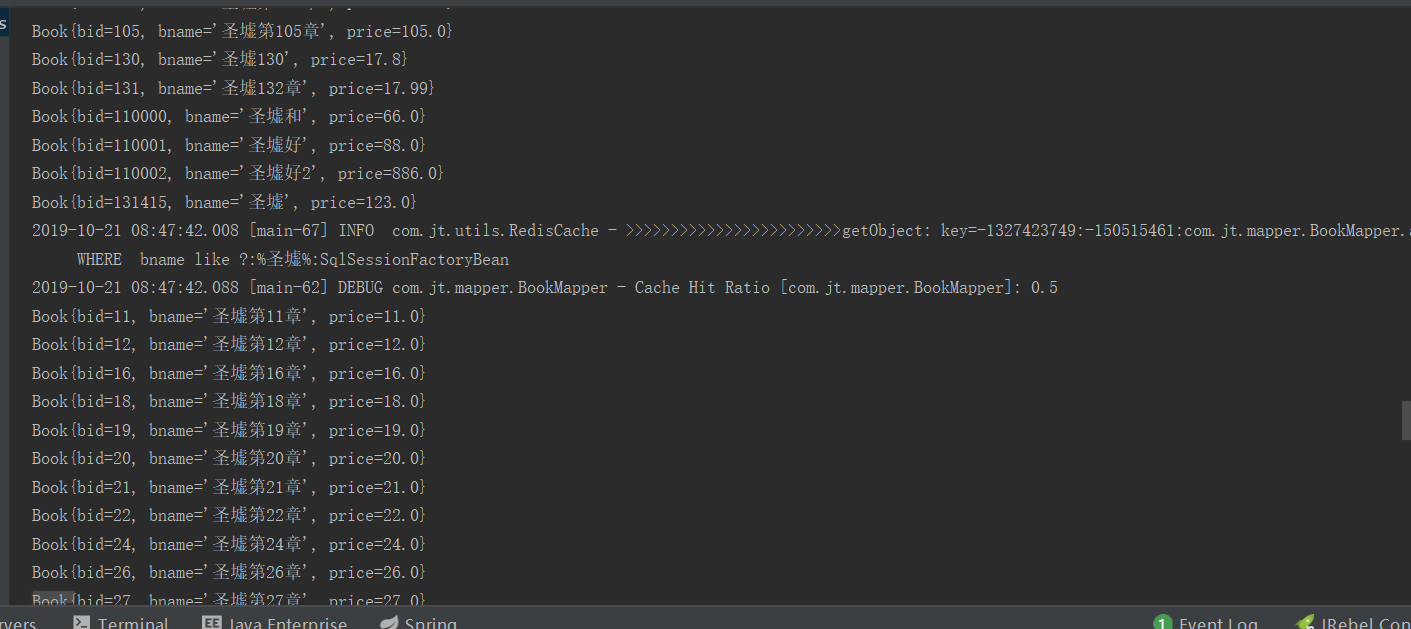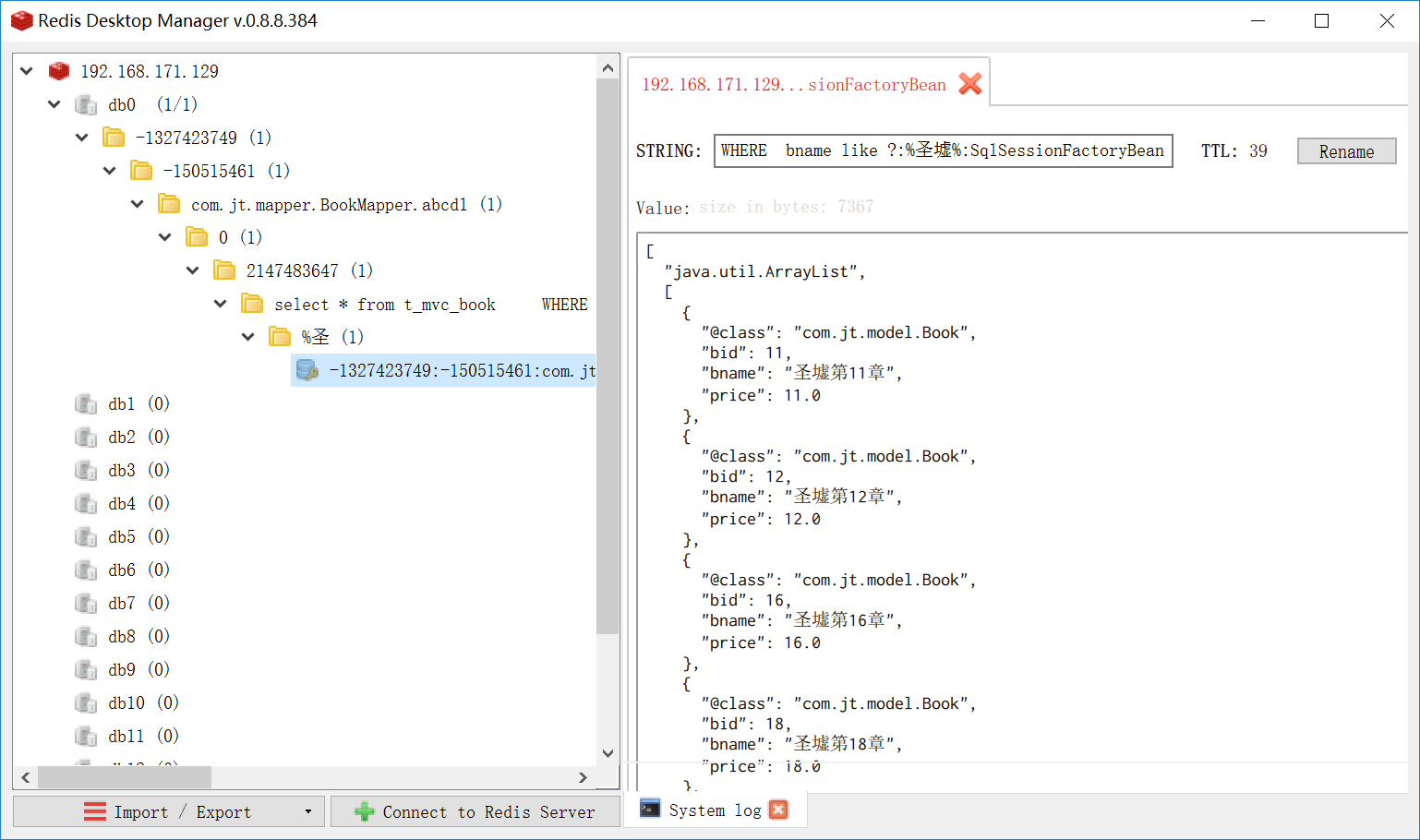Mybatis整合Redis实现二级缓存
Mybatis集成ehcache
. 为什么需要缓存
拉高程序的性能 . 什么样的数据需要缓存
很少被修改或根本不改的数据 业务场景比如:耗时较高的统计分析sql、电话账单查询sql等 . ehcache是什么
Ehcache 是现在最流行的纯Java开源缓存框架,配置简单、结构清晰、功能强大 注1:本章介绍的是2.X版本,.x的版本和2.x的版本API差异比较大 . ehcache的特点
4.1 够快
Ehcache的发行有一段时长了,经过几年的努力和不计其数的性能测试,Ehcache终被设计于large, high concurrency systems.
4.2 够简单
开发者提供的接口非常简单明了,从Ehcache的搭建到运用运行仅仅需要的是你宝贵的几分钟。其实很多开发者都不知道自己用在用Ehcache,Ehcache被广泛的运用于其他的开源项目
4.3 够袖珍
关于这点的特性,官方给了一个很可爱的名字small foot print ,一般Ehcache的发布版本不会到2M,V 2.2. 才 668KB。
4.4 够轻量
核心程序仅仅依赖slf4j这一个包,没有之一!
4.5 好扩展
Ehcache提供了对大数据的内存和硬盘的存储,最近版本允许多实例、保存对象高灵活性、提供LRU、LFU、FIFO淘汰算法,基础属性支持热配置、支持的插件多
4.6 监听器
缓存管理器监听器 (CacheManagerListener)和 缓存监听器(CacheEvenListener),做一些统计或数据一致性广播挺好用的
4.7 分布式缓存
从Ehcache .2开始,支持高性能的分布式缓存,兼具灵活性和扩展性
先来导入POM依赖
<dependency>
<groupId>org.springframework</groupId>
<artifactId>spring-context-support</artifactId>
<version>${spring.version}</version>
</dependency> <!--mybatis与ehcache整合-->
<dependency>
<groupId>org.mybatis.caches</groupId>
<artifactId>mybatis-ehcache</artifactId>
<version>1.1.</version>
</dependency> <!--ehcache依赖-->
<dependency>
<groupId>net.sf.ehcache</groupId>
<artifactId>ehcache</artifactId>
<version>2.10.</version>
</dependency>
还要修改下一些配置
<!-- log4j2日志配置相关依赖 -->
<log4j2.version>2.9.</log4j2.version>
<log4j2.disruptor.version>3.2.</log4j2.disruptor.version>
<slf4j.version>1.7.</slf4j.version> <!-- log4j2日志相关依赖 -->
<!-- log配置:Log4j2 + Slf4j -->
<!-- slf4j核心包-->
<dependency>
<groupId>org.slf4j</groupId>
<artifactId>slf4j-api</artifactId>
<version>${slf4j.version}</version>
</dependency>
<dependency>
<groupId>org.slf4j</groupId>
<artifactId>jcl-over-slf4j</artifactId>
<version>${slf4j.version}</version>
<scope>runtime</scope>
</dependency> <!--核心log4j2jar包-->
<dependency>
<groupId>org.apache.logging.log4j</groupId>
<artifactId>log4j-api</artifactId>
<version>${log4j2.version}</version>
</dependency>
<dependency>
<groupId>org.apache.logging.log4j</groupId>
<artifactId>log4j-core</artifactId>
<version>${log4j2.version}</version>
</dependency>
<!--用于与slf4j保持桥接-->
<dependency>
<groupId>org.apache.logging.log4j</groupId>
<artifactId>log4j-slf4j-impl</artifactId>
<version>${log4j2.version}</version>
</dependency>
<!--web工程需要包含log4j-web,非web工程不需要-->
<dependency>
<groupId>org.apache.logging.log4j</groupId>
<artifactId>log4j-web</artifactId>
<version>${log4j2.version}</version>
<scope>runtime</scope>
</dependency> <!--需要使用log4j2的AsyncLogger需要包含disruptor-->
<dependency>
<groupId>com.lmax</groupId>
<artifactId>disruptor</artifactId>
<version>${log4j2.disruptor.version}</version>
</dependency>
在Resource中添加一个ehcache.xml的配置文件
<?xml version="1.0" encoding="UTF-8"?>
<ehcache xmlns:xsi="http://www.w3.org/2001/XMLSchema-instance"
xsi:noNamespaceSchemaLocation="http://ehcache.org/ehcache.xsd"
updateCheck="false">
<!--磁盘存储:将缓存中暂时不使用的对象,转移到硬盘,类似于Windows系统的虚拟内存-->
<!--path:指定在硬盘上存储对象的路径-->
<!--java.io.tmpdir 是默认的临时文件路径。 可以通过如下方式打印出具体的文件路径 System.out.println(System.getProperty("java.io.tmpdir"));-->
<diskStore path="java.io.tmpdir"/> <!--defaultCache:默认的管理策略-->
<!--eternal:设定缓存的elements是否永远不过期。如果为true,则缓存的数据始终有效,如果为false那么还要根据timeToIdleSeconds,timeToLiveSeconds判断-->
<!--maxElementsInMemory:在内存中缓存的element的最大数目-->
<!--overflowToDisk:如果内存中数据超过内存限制,是否要缓存到磁盘上-->
<!--diskPersistent:是否在磁盘上持久化。指重启jvm后,数据是否有效。默认为false-->
<!--timeToIdleSeconds:对象空闲时间(单位:秒),指对象在多长时间没有被访问就会失效。只对eternal为false的有效。默认值0,表示一直可以访问-->
<!--timeToLiveSeconds:对象存活时间(单位:秒),指对象从创建到失效所需要的时间。只对eternal为false的有效。默认值0,表示一直可以访问-->
<!--memoryStoreEvictionPolicy:缓存的3 种清空策略-->
<!--FIFO:first in first out (先进先出)-->
<!--LFU:Less Frequently Used (最少使用).意思是一直以来最少被使用的。缓存的元素有一个hit 属性,hit 值最小的将会被清出缓存-->
<!--LRU:Least Recently Used(最近最少使用). (ehcache 默认值).缓存的元素有一个时间戳,当缓存容量满了,而又需要腾出地方来缓存新的元素的时候,那么现有缓存元素中时间戳离当前时间最远的元素将被清出缓存-->
<defaultCache eternal="false" maxElementsInMemory="" overflowToDisk="false" diskPersistent="false"
timeToIdleSeconds="" timeToLiveSeconds="" memoryStoreEvictionPolicy="LRU"/> <!--name: Cache的名称,必须是唯一的(ehcache会把这个cache放到HashMap里)-->
<!--<cache name="stuCache" eternal="false" maxElementsInMemory=""-->
<!--overflowToDisk="false" diskPersistent="false" timeToIdleSeconds=""-->
<!--timeToLiveSeconds="" memoryStoreEvictionPolicy="LRU"/>-->
</ehcache>
applicationContext-mybatis.xml中添加
<!--设置mybaits对缓存的支持-->
<property name="configurationProperties">
<props>
<!-- 全局映射器启用缓存 *主要将此属性设置完成即可-->
<prop key="cacheEnabled">true</prop>
<!-- 查询时,关闭关联对象即时加载以提高性能 -->
<prop key="lazyLoadingEnabled">false</prop>
<!-- 设置关联对象加载的形态,此处为按需加载字段(加载字段由SQL指 定),不会加载关联表的所有字段,以提高性能 -->
<prop key="aggressiveLazyLoading">true</prop>
</props>
</property>
在XxxMapper.xml中配置cache

可以通过select标签的useCache属性打开或关闭二级缓存

1、mybatis默认使用的二级缓存框架就是ehcache(org.mybatis.caches.ehcache.EhcacheCache),无缝结合
2、Mybatis缓存开关一旦开启,可缓存单条记录,也可缓存多条,hibernate不能缓存多条。
3、Mapper接口上的所有方法上另外提供关闭缓存的属性
Mybatis集成redis
添加jar依赖
2.1 添加redis相关依赖
<!-- redis与spring的整合依赖 -->
<redis.version>2.9.</redis.version>
<redis.spring.version>1.7..RELEASE</redis.spring.version> <dependency>
<groupId>redis.clients</groupId>
<artifactId>jedis</artifactId>
<version>${redis.version}</version>
</dependency>
<dependency>
<groupId>org.springframework.data</groupId>
<artifactId>spring-data-redis</artifactId>
<version>${redis.spring.version}</version>
</dependency>
版本冲突问题:
1. ClassNotFoundException : redis/client/util/geoUtils 说这个类找不到。
2. org.springframework.beans.factory.BeanCreationException: Error creating bean with name 'redisTemplate' defined in class path resource [applicationContext.xml]
说创建 redisTemplate bean 对象时失败了。
redis.client 2.9.0 ---- spring-data-redis 1.7.1.RELEASE
redis.client 2.9.0 ---- spring-data-redis 1.7.2.RELEASE 这两个是可以使用的
2.2 log4j2配置
2.3 jackson
<!-- jackson -->
<jackson.version>2.9.</jackson.version> <!-- jackson -->
<dependency>
<groupId>com.fasterxml.jackson.core</groupId>
<artifactId>jackson-databind</artifactId>
<version>${jackson.version}</version>
</dependency>
<dependency>
<groupId>com.fasterxml.jackson.core</groupId>
<artifactId>jackson-core</artifactId>
<version>${jackson.version}</version>
</dependency>
<dependency>
<groupId>com.fasterxml.jackson.core</groupId>
<artifactId>jackson-annotations</artifactId>
<version>${jackson.version}</version>
</dependency>
3.spring + redis 集成实现缓存功能(与mybatis无关)
3.1 添加两个redis的配置文件,并将redis.properties和applicationContext-redis.xml配置到applicationContext.xml文件中
redis.properties
redis.hostName=192.168.171.129
redis.port=
redis.password=
redis.timeout=
redis.maxIdle=
redis.maxTotal=
redis.maxWaitMillis=
redis.minEvictableIdleTimeMillis=
redis.numTestsPerEvictionRun=
redis.timeBetweenEvictionRunsMillis=
redis.testOnBorrow=true
redis.testWhileIdle=true
applicationContext-redis.xml
<?xml version="1.0" encoding="UTF-8"?>
<beans xmlns="http://www.springframework.org/schema/beans"
xmlns:xsi="http://www.w3.org/2001/XMLSchema-instance"
xmlns:context="http://www.springframework.org/schema/context"
xsi:schemaLocation="http://www.springframework.org/schema/beans http://www.springframework.org/schema/beans/spring-beans.xsd http://www.springframework.org/schema/context http://www.springframework.org/schema/context/spring-context.xsd"> <!-- . 引入properties配置文件 -->
<!--<context:property-placeholder location="classpath:redis.properties" />--> <!-- . redis连接池配置-->
<bean id="poolConfig" class="redis.clients.jedis.JedisPoolConfig">
<!--最大空闲数-->
<property name="maxIdle" value="${redis.maxIdle}"/>
<!--连接池的最大数据库连接数 -->
<property name="maxTotal" value="${redis.maxTotal}"/>
<!--最大建立连接等待时间-->
<property name="maxWaitMillis" value="${redis.maxWaitMillis}"/>
<!--逐出连接的最小空闲时间 默认1800000毫秒(30分钟)-->
<property name="minEvictableIdleTimeMillis" value="${redis.minEvictableIdleTimeMillis}"/>
<!--每次逐出检查时 逐出的最大数目 如果为负数就是 : /abs(n), 默认3-->
<property name="numTestsPerEvictionRun" value="${redis.numTestsPerEvictionRun}"/>
<!--逐出扫描的时间间隔(毫秒) 如果为负数,则不运行逐出线程, 默认--->
<property name="timeBetweenEvictionRunsMillis" value="${redis.timeBetweenEvictionRunsMillis}"/>
<!--是否在从池中取出连接前进行检验,如果检验失败,则从池中去除连接并尝试取出另一个-->
<property name="testOnBorrow" value="${redis.testOnBorrow}"/>
<!--在空闲时检查有效性, 默认false -->
<property name="testWhileIdle" value="${redis.testWhileIdle}"/>
</bean> <!-- . redis连接工厂 -->
<bean id="connectionFactory" class="org.springframework.data.redis.connection.jedis.JedisConnectionFactory"
destroy-method="destroy">
<property name="poolConfig" ref="poolConfig"/>
<!--IP地址 -->
<property name="hostName" value="${redis.hostName}"/>
<!--端口号 -->
<property name="port" value="${redis.port}"/>
<!--如果Redis设置有密码 -->
<property name="password" value="${redis.password}"/>
<!--客户端超时时间单位是毫秒 -->
<property name="timeout" value="${redis.timeout}"/>
</bean> <!-- . redis操作模板,使用该对象可以操作redis -->
<bean id="redisTemplate" class="org.springframework.data.redis.core.RedisTemplate">
<property name="connectionFactory" ref="connectionFactory"/>
<!--如果不配置Serializer,那么存储的时候缺省使用String,如果用User类型存储,那么会提示错误User can't cast to String!! -->
<property name="keySerializer">
<bean class="org.springframework.data.redis.serializer.StringRedisSerializer"/>
</property>
<property name="valueSerializer">
<bean class="org.springframework.data.redis.serializer.GenericJackson2JsonRedisSerializer"/>
</property>
<property name="hashKeySerializer">
<bean class="org.springframework.data.redis.serializer.StringRedisSerializer"/>
</property>
<property name="hashValueSerializer">
<bean class="org.springframework.data.redis.serializer.GenericJackson2JsonRedisSerializer"/>
</property>
<!--开启事务 -->
<property name="enableTransactionSupport" value="true"/>
</bean> <!-- .使用中间类解决RedisCache.RedisTemplate的静态注入,从而使MyBatis实现第三方缓存 -->
<bean id="redisCacheTransfer" class="com.jt.util.RedisCacheTransfer">
<property name="redisTemplate" ref="redisTemplate"/>
</bean>
</beans>
applicationContext.xml

3.2 将redis缓存引入到mybatis中
3.1 创建mybatis的自定义缓存类“RedisCache”,必须实现org.apache.ibatis.cache.Cache接口
RedisCache.java
package com.jt.util; import org.apache.ibatis.cache.Cache;
import org.slf4j.Logger;
import org.slf4j.LoggerFactory;
import org.springframework.dao.DataAccessException;
import org.springframework.data.redis.connection.RedisConnection;
import org.springframework.data.redis.core.RedisCallback;
import org.springframework.data.redis.core.RedisTemplate; import java.util.concurrent.TimeUnit;
import java.util.concurrent.locks.ReadWriteLock;
import java.util.concurrent.locks.ReentrantReadWriteLock; public class RedisCache implements Cache //实现类
{
private static final Logger logger = LoggerFactory.getLogger(RedisCache.class); private static RedisTemplate<String,Object> redisTemplate; private final String id; /**
* The {@code ReadWriteLock}.
*/
private final ReadWriteLock readWriteLock = new ReentrantReadWriteLock(); @Override
public ReadWriteLock getReadWriteLock()
{
return this.readWriteLock;
} public static void setRedisTemplate(RedisTemplate redisTemplate) {
RedisCache.redisTemplate = redisTemplate;
} public RedisCache(final String id) {
if (id == null) {
throw new IllegalArgumentException("Cache instances require an ID");
}
logger.debug("MybatisRedisCache:id=" + id);
this.id = id;
} @Override
public String getId() {
return this.id;
} @Override
public void putObject(Object key, Object value) {
try{
logger.info(">>>>>>>>>>>>>>>>>>>>>>>>putObject: key="+key+",value="+value);
if(null!=value)
redisTemplate.opsForValue().set(key.toString(),value,, TimeUnit.SECONDS);
}catch (Exception e){
e.printStackTrace();
logger.error("redis保存数据异常!");
}
} @Override
public Object getObject(Object key) {
try{
logger.info(">>>>>>>>>>>>>>>>>>>>>>>>getObject: key="+key);
if(null!=key)
return redisTemplate.opsForValue().get(key.toString());
}catch (Exception e){
e.printStackTrace();
logger.error("redis获取数据异常!");
}
return null;
} @Override
public Object removeObject(Object key) {
try{
if(null!=key)
return redisTemplate.expire(key.toString(),,TimeUnit.DAYS);
}catch (Exception e){
e.printStackTrace();
logger.error("redis获取数据异常!");
}
return null;
} @Override
public void clear() {
Long size=redisTemplate.execute(new RedisCallback<Long>() {
@Override
public Long doInRedis(RedisConnection redisConnection) throws DataAccessException {
Long size = redisConnection.dbSize();
//连接清除数据
redisConnection.flushDb();
redisConnection.flushAll();
return size;
}
});
logger.info(">>>>>>>>>>>>>>>>>>>>>>>>clear: 清除了" + size + "个对象");
} @Override
public int getSize() {
Long size = redisTemplate.execute(new RedisCallback<Long>() {
@Override
public Long doInRedis(RedisConnection connection)
throws DataAccessException {
return connection.dbSize();
}
});
return size.intValue();
}
}
3.2 静态注入中间类“RedisCacheTransfer”,解决RedisCache中RedisTemplate的静态注入,从而使MyBatis实现第三方缓存
RedisCacheTransfer.java
package com.jt.util; import org.springframework.beans.factory.annotation.Autowired;
import org.springframework.data.redis.core.RedisTemplate; public class RedisCacheTransfer {
@Autowired
public void setRedisTemplate(RedisTemplate redisTemplate) {
RedisCache.setRedisTemplate(redisTemplate);
}
}
3.3 spring与mybatis整合文件中开发二级缓存
<!--设置mybaits对缓存的支持-->
<property name="configurationProperties">
<props>
<!-- 全局映射器启用缓存 *主要将此属性设置完成即可-->
<prop key="cacheEnabled">true</prop>
<!-- 查询时,关闭关联对象即时加载以提高性能 -->
<prop key="lazyLoadingEnabled">false</prop>
<!-- 设置关联对象加载的形态,此处为按需加载字段(加载字段由SQL指 定),不会加载关联表的所有字段,以提高性能 -->
<prop key="aggressiveLazyLoading">true</prop>
</props>
</property>
3.4 在BookMapper.xml中添加自定义cache功能
<cache type="com.jt.util.RedisCache"
eviction="LRU"
flushInterval=""
size=""
readOnly="false"></cache>
测试代码
@Test
public void testCacheMary() {
Book book=new Book();
book.setBname( StringUtils.toLikeStr("圣墟"));
PageBean pageBean=new PageBean();
// pageBean.setPage(4);
List<Book> abcd=this.bookService.abcd1(book,pageBean);
for (Book m : abcd) {
System.out.println(m);
}
List<Book> abcd1=this.bookService.abcd1(book,pageBean);
for (Book m : abcd) {
System.out.println(m);
} }


Mybatis整合Redis实现二级缓存的更多相关文章
- SSM+redis整合(mybatis整合redis做二级缓存)
SSM:是Spring+Struts+Mybatis ,另外还使用了PageHelper 前言: 这里主要是利用redis去做mybatis的二级缓存,mybaits映射文件中所有的select都会刷 ...
- mybatis 整合redis作为二级缓存
核心关键在于定义一个RedisCache实现mytis实现的Cache接口 ** * @author tele * @Description RedisCache由于需要传入id, 由mybatis进 ...
- mybatis 使用redis实现二级缓存(spring boot)
mybatis 自定义redis做二级缓存 前言 如果关注功能实现,可以直接看功能实现部分 何时使用二级缓存 一个宗旨---不常变的稳定而常用的 一级是默认开启的sqlsession级别的. 只在单表 ...
- SpringMVC + MyBatis + Mysql + Redis(作为二级缓存) 配置
2016年03月03日 10:37:47 标签: mysql / redis / mybatis / spring mvc / spring 33805 项目环境: 在SpringMVC + MyBa ...
- SpringMVC +Spring + MyBatis + Mysql + Redis(作为二级缓存) 配置
转载:http://blog.csdn.net/xiadi934/article/details/50786293 项目环境: 在SpringMVC +Spring + MyBatis + MySQL ...
- SpringBank 开发日志 Mybatis 使用redis 作为二级缓存时,无法通过cacheEnabled=false 将其关闭
<?xml version="1.0" encoding="UTF-8" ?> <!DOCTYPE configuration PUBLIC ...
- mybatis结合redis实战二级缓存(六)
之前的文章中我们意见分析了一级缓存.二级缓存的相关源码和基本原理,今天我们来分享下了mybatis二级缓存和redis的结合,当然mybatis二级缓存也可以和ehcache.memcache.OSC ...
- mybatis结合redis实战二级缓存
之前的文章中我们意见分析了一级缓存.二级缓存的相关源码和基本原理,今天我们来分享下了mybatis二级缓存和redis的结合,当然mybatis二级缓存也可以和ehcache.memcache.OSC ...
- springboot+mybatis 用redis作二级缓存
1.加入相关依赖包: <?xml version="1.0" encoding="UTF-8"?> <project xmlns=" ...
随机推荐
- MySQL 两张表关联更新(用一个表的数据更新另一个表的数据)
有两张表,info1, info2 . info1: info2: 现在,要用info2中的数据更新info1中对应的学生信息,sql语句如下: UPDATE info1 t1 JOIN info2 ...
- zuul实现的限流
限流一般可以根据客户端IP,请求的URL,用户登陆信息进行限制,每秒钟限制多次数,这从别一方面也提升了系统的性能,无用的并发没那么多了. 依赖包 <dependency> <grou ...
- WestWild: 1.1: Vulnhub Walkthorugh
启动界面 主机层面扫描: ╰─ nmap -p1-65535 -sV -A 10.10.202.131 Starting Nmap 7.70 ( https://nmap.org ) at 2019- ...
- Github访问速度很慢的原因,以及解决方法
1,CDN,Content Distribute Network,可以直译成内容分发网络,CDN解决的是如何将数据快速可靠从源站传递到用户的问题.用户获取数据时,不需要直接从源站获取,通过CDN对于数 ...
- 4、netty第三个例子,建立一个tcp的聊天的程序
代码基于第二个例子,支持多客户端的连接,在线聊天. 主要思路: 连接建立时,在服务器端,保存channel 对象,当有新的客户端加入时,遍历保存的channel集合,向其他客户端发送加入消息. 当一个 ...
- vmware vsphere client 虚拟机动态添加磁盘
0x00 事件 为了在虚拟机添加了磁盘之后,不重启机器加载新磁盘. 如上图,添加了一块 10G 的磁盘之后. 在虚拟机中是看不到新添加的磁盘: 0x01 解决 运行如下命令,通过重新扫描 SCSI ( ...
- Go语言系列:(1)在VsCode中配置Go的开发环境
一.为什么选VSCode 这个系列的初宗是带领公司的PHPer转Go,在正式写这篇博文前,咱们先说说Go有哪些主流的IDE 1.GoLand(收费) JetBrains出品必属精品,除了贵没有其它缺点 ...
- openstack-neutron安装与配置
一.实验目的: 1.理解neutron服务在OpenStack中的作用 2.掌握在控制节点上安装配置neutron的方法和步骤 3.掌握在计算节点上安装与配置neutron的方法和步骤 二.实验步骤: ...
- Vant-Weap通过事件获取值
van-field框的使用 和通过事件获取值 <van-cell-group> <van-field value="{{username}}" label=&qu ...
- 洛谷 UVA1328 Period
洛谷 UVA1328 Period 洛谷传送门 题目描述 PDF 输入格式 无 输出格式 无 题意翻译 题意描述 对于给定字符串S的每个前缀,我们想知道它是否为周期串.也就还是说,它是否为某一字符串重 ...
